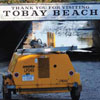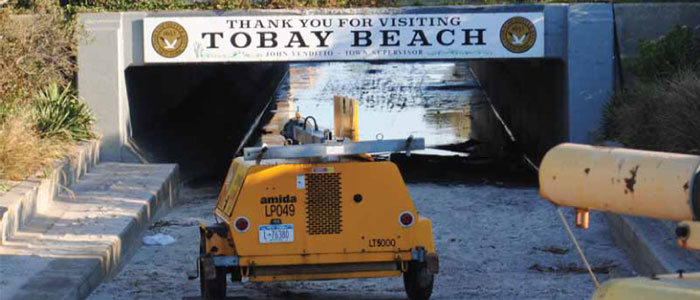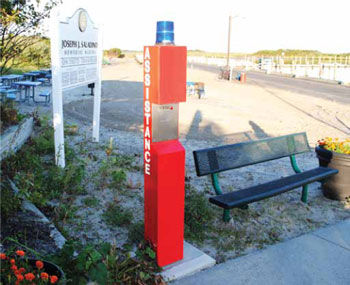
Covering Oyster Bay
Wayward tropical storm blitzes New York coastline, emergency intact
- By Samuel Shanes
- Apr 01, 2012

The town of Oyster Bay, part of the New York metropolitan area, is the only town in Nassau County that extends from the North Shore to the South Shore of Long Island. The area was home to Theodore Roosevelt, who spent summers at his residence, Sagamore Hill, in the village of Cove Neck.
In recent years, the township has proactively installed VoIP emergency phones throughout the town’s recreational areas, including more than 2,000 acres of parks, beaches, golf courses, marinas, garages, community centers, train stations, municipal buildings and storage yards. John Venditto, town supervisor, has made safety and security a priority in Oyster Bay, which showed when he put out a mandate requiring that all new emergency phones with network capabilities comply with VoIP standards.
“Our recreational facilities are very busy, with thousands of people using them daily,” said Justin McCaffrey, commissioner of Oyster Bay’s Department of Public Safety. “We feel that the call boxes are an efficient, quick way to summon assistance. We also feel the call boxes provide a reassuring comfort level and act as a deterrent to crime.”
Prior to going to IP, the town had been using Talk-A-Phone analog emergency phones throughout the city.

Support the Technology
When the mandate came and the infrastructure was ready to support the VoIP technology, it was time to upgrade the emergency communications equipment. As an added benefit, the city was then able to use Talk-A-Phone’s mass notification solution with VoIP phones.
The township approved building a stateof- the-art parking facility, which was to include the latest technological advancements in emergency communications as well as mass notification systems as part of the upgrade.
LPC Inc. was commissioned to design a VoIP emergency phone solution for the Hicksville parking facility. The company also was tasked with integrating Talk-APhone’s WEBS Contact® mass notification platform. With more than two years of reliable service, LPC has developed a strong partnership with the township. The company proposed Talk-A-Phone’s VOIP- 500 series emergency phones because they seamlessly operate over a shared digital infrastructure with other IP technologies.
“The original design was done by a consulting engineer,” recollects William Eggers, vice president of LPC. “However, this did not address all the concerns of implementing a unified solution for emergency phones, card access and CCTV. We took the lead on the project and coordinated all IP infrastructure with the town’s IT department, while other specialists installed card access and CCTV.”
LPC took the project planning seriously; running multiple vendors on a shared IP network requires careful consideration. Distance limitations, power requirements and environmental concerns all had to be addressed. A unified approach quickly proved to be the most technologically advanced and cost-efficient solution for the town.
Talk-A-Phone’s WEBS Contact mass notification platform and VoIP emergency phones were configured to be part of a unified mass notification system. The WEBS Contact server, as well as the phone system and gateways, all reside at the Department of Public Works, which is located miles away from the site and is connected though a fiber network.
Installation of VoIP emergency phones and the WEBS Contact platform were not new to LPC. Talk-A-Phone has had a certification course in VoIP telephony and mass notification systems since the beginning of 2010. The certification course offers all participants hands-on experience setting up VoIP emergency phones and the WEBS Contact platform.
“The training definitely helped our technicians during the installation,” Eggers said of his company’s decision to take part in Talk- A-Phone’s certification program. “We especially appreciated the hands-on approach. There are a lot of companies out there who like to conduct online training, but I like to have the product in my hands. This way, if something doesn’t work, the trainer is there to show me exactly what I did wrong.”
LPC’s technicians successfully completed Talk-A-Phone’s one-day certification course, earning LPC the status of Talk-APhone Certified Partner, a group exclusively authorized to install Talk-A-Phone’s mass notification system.
With certification under its belt, LPC took the lead in the Town of Oyster Bay project. Talk-A-Phone’s VOIP-500 emergency phones were first installed on a test network with other vendors’ products. Because of the critical nature of emergency calls, Quality of Service was implemented to prioritize emergency communications between the township’s phone system, gateways and the emergency phones.
After the configuration of the VoIP emergency phones was complete, all phones were registered with the WEBS Contact mass notification server, enabling it to send audio broadcasts to VoIP phones. The VOIP-500 emergency phones are used primarily as emergency communications devices but also can be paged at high volume, exceeding 90dB, to deliver site-specific instructions to individual units, groups of units or all-at-once.
WEBS Contact allows emergency personnel to issue targeted audio alerts to predefined segments of the facility with a few clicks of a button. At the same time, the system can deliver SMS messages and emails to groups of recipients via third-party gateways.
As part of the project, Talk-A-Phone designed an emergency phone tower that can accommodate two CCTV cameras on a T-shaped camera arm. Using two CCTV cameras on the same tower opens up unique video surveillance options and widens the operator’s view of the surroundings. Another approach would be to use a 360-degree awareness camera paired together with a PTZ camera.
According to McCaffrey, “Many of the call-boxes are equipped with surveillance cameras, which are recording the events and can be viewed at the operations center at the same time. Live video feeds can provide updated information to the first responders and public safety staff who are responding to an incident.”
Both cameras installed on the tower can be activated by the VOIP-500 emergency phone using the phone’s auxiliary contacts. A PTZ camera can be moved to a preset location on events such as the call being placed or assistance being summoned.
The Town of Oyster Bay continues to add Talk-A-Phone units throughout the area. “We are very happy with the system,” McCaffrey said. “It has proven to be reliable and vandalresistant, and it projects a positive image of safety and security at our facilities.”
Extensive planning and staged testing of the entire system by LPC’s technicians gave the Town of Oyster Bay IT department peace of mind. When the day came to flip the network switch to the ‘ON’ position, everything came online as anticipated. Thanks to LPC’s efforts, Oyster Bay citizens and visitors can benefit from the township’s public safety initiative.
Hurricane Irene Puts System to a Test
Not long after LPC finished the installation at the parking facility and town’s recreational areas, the emergency communications system was tested against the elements. Hurricane Irene ravaged the entire East Coast in September of 2011, causing loss and massive destruction along the way. It was estimated that five million homes were in the dark without certainty of when electric power would be restored.
President Barack Obama issued a state of emergency declaration for many parts of the battered coast, freeing federal disaster funds and tasking the Federal Emergency Management Agency (FEMA) and the Department of Homeland Security (DHS) to coordinate the disaster relief efforts.
During challenging times like this, emergency communications are critical. The survivability of equipment can be the difference between life and death. Hurricane Irene put Talk-A-Phone’s emergency communications equipment to a harsh test.
Many emergency phone towers and wall mounts are located on Oyster Bay’s south shore beaches, which were affected the most during the hurricane. In the aftermath, LPC was quick to respond to the maintenance call on the emergency phone system. What technicians found was not as grim as expected.
“When the hurricane came, the tides were so great that they lifted the entire deck two feet,” Eggers said. “We didn’t think any emergency communications equipment would survive. To our surprise, all Talk- A-Phone’s phones were still functioning even after being completely submerged into water and beaten hard by the debris and wind!”
All south shore beaches and most north shore beaches remained closed for clean-up operations and until the power could be completely restored. The Oyster Bay community worked hard to bring the town back from Irene’s devastation.
Some of the VOIP-500 emergency phones that took the most damage due to their proximity to the ocean were returned to the Talk-A-Phone factory for examination. None of the emergency phones, towers or wall mounts was affected by the hurricane, even though the water surge brought massive amounts of sand and debris, destroying weaker structures along the way. An important emergency lifeline was preserved and stood strong in the face of a hurricane.
This article originally appeared in the April 2012 issue of Security Today.
About the Author
Samuel Shanes is the chairman of Talkaphone.